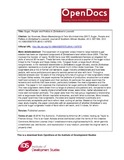Sugar, People and Politics in Zimbabwe’s Lowveld
| dc.contributor.author | Scoones, Ian | |
| dc.contributor.author | Mavedzenge, Blasio | |
| dc.contributor.author | Murimbarimba, Felix | |
| dc.coverage.spatial | Zimbabwe | en |
| dc.date.accessioned | 2017-06-22T15:42:14Z | |
| dc.date.available | 2017-06-22T15:42:14Z | |
| dc.date.issued | 2016-09-15 | |
| dc.identifier.citation | Ian Scoones, Blasio Mavedzenge & Felix Murimbarimba (2017) Sugar, People and Politics in Zimbabwe’s Lowveld, Journal of Southern African Studies, 43:3, 567-584, DOI: 10.1080/03057070.2016.1187972 | en |
| dc.identifier.issn | 1465-3893 | |
| dc.identifier.uri | https://opendocs.ids.ac.uk/opendocs/handle/20.500.12413/13021 | |
| dc.description.abstract | The expansion of outgrower areas linked to large lowveld sugar estates has been an important component of Zimbabwe’s land reform since 2000. This has involved the transfer of nearly 16,000 ha to over 800 resettlement farmers on irrigated ‘A2’ plots of around 20 ha each. These farmers now produce around a quarter of the sugar output linked to the Triangle and Hippo Valley mills. Tongaat Hulett, a large South African conglomerate, is the dominant shareholder in Zimbabwe’s sugar industry, and its Zimbabwe operation represents a crucial part of the overall multi-million-dollar business. The new outgrowers are a mix of former civil servants, sugar industry professionals and business people, with some politicians and security service personnel also with land. Through a detailed analysis over 12 years of the changing fortunes of a group of new outgrowers linked to Hippo Valley estate, the paper explores the patterns of production, employment and wider livelihood contexts of outgrowers and their workers. In particular the paper examines the tensions and conflicts that have arisen, particularly between the new outgrowers and the estate. The paper in turn explores the implications for sugar politics in Zimbabwe’s Lowveld. The new outgrowers were drawn from a range of previous occupations and, compared to land reform beneficiaries in nearby dryland smallholder areas, were richer, better educated and more well-connected politically. The paper asks how this new group negotiated a relationship with a large-scale South African capitalist enterprise, and with what outcomes. More broadly, the paper examines how outgrowers, the state and capital brokered a politically and economically acceptable post-land reform deal, suiting all parties. Based on the longitudinal case study insights, the paper concludes with an assessment of whether Zimbabwe’s very particular sugar outgrower model of land reform will work, and if it does, for whom. | en |
| dc.language.iso | en | en |
| dc.publisher | Taylor and Francis | en |
| dc.rights | This is an Open Access article distributed under the terms of the Creative Commons Attribution License (http:// creativecommons.org/licenses/by/4.0/), which permits unrestricted use, distribution, and reproduction in any medium, provided the original work is properly cited. | en |
| dc.rights.uri | http://creativecommons.org/licenses/by/4.0/ | en |
| dc.subject | Agriculture | en |
| dc.subject | Politics and Power | en |
| dc.title | Sugar, People and Politics in Zimbabwe’s Lowveld | en |
| dc.type | Article | en |
| dc.rights.holder | © 2016 The Author(s). | en |
| dc.identifier.externaluri | http://dx.doi.org/10.1080/03057070.2016.1187972 | en |
| dc.identifier.doi | 10.1080/03057070.2016.1187972 | |
| dcterms.dateAccepted | 2016-09-15 | |
| rioxxterms.funder | Default funder | en |
| rioxxterms.identifier.project | Default project | en |
| rioxxterms.version | VoR | en |
| rioxxterms.versionofrecord | 10.1080/03057070.2016.1187972 | en |
| rioxxterms.funder.project | c941507f-fd0b-4fc3-9822-4b2132f61a1d | en |
Files in this item
This item appears in the following Collection(s)
-
IDS Research [1671]
Except where otherwise noted, this item's license is described as This is an Open Access article distributed under the terms of the Creative Commons Attribution License (http://
creativecommons.org/licenses/by/4.0/), which permits unrestricted use, distribution, and reproduction in any medium,
provided the original work is properly cited.


